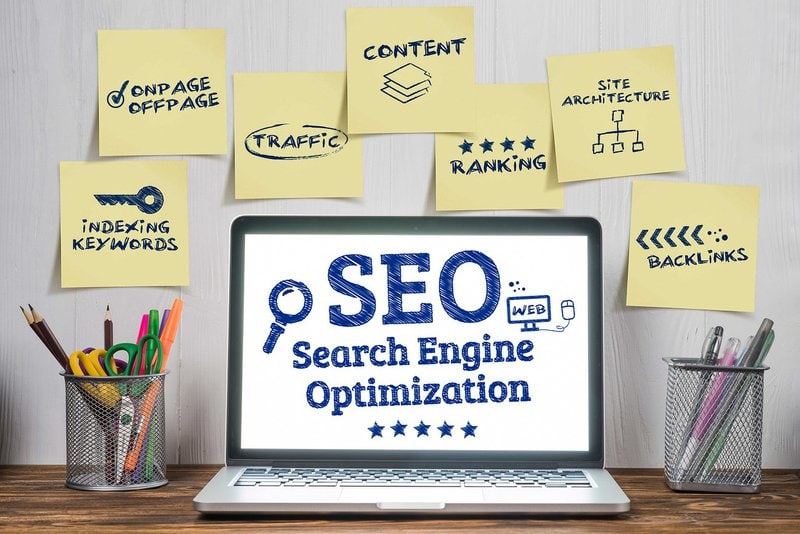Blog SEO: Optimizing For Higher Search Engine Rankings

Blog SEO, or search engine optimization, refers to the process of optimizing a blog to improve its visibility and ranking on search engine results pages (SERPs).
This article aims to provide a comprehensive understanding of blog SEO and how it can help bloggers achieve higher search engine rankings.
The importance of blog SEO cannot be overstated in today’s digital world, where millions of blogs compete for attention. By implementing effective SEO strategies, bloggers can increase their organic traffic, attract a larger audience, and ultimately boost their online visibility.
This article will cover key aspects of blog SEO, including:
- Conducting keyword research
- Optimizing meta tags and titles
- Creating high-quality content
- Utilizing internal and external links
- Optimizing URL structure
- Improving loading speed
- Tracking SEO performance.
By following these best practices, bloggers can enhance their blog’s chances of ranking higher in search engine results, thus increasing their chances of being discovered by potential readers and driving more traffic to their blog.
Key Takeaways
- Implementing effective SEO strategies improves visibility and ranking on search engine results pages (SERPs).
- Conducting keyword research helps identify high-volume, low-competition keywords relevant to the blog’s niche.
- Optimizing meta tags and titles with relevant keywords improves visibility in search engine results.
- Creating high-quality, engaging content attracts and retains readers, increasing organic traffic and driving more traffic to the blog.
Understanding the Importance of Blog SEO
Understanding the significance of blog SEO is crucial for enhancing search engine rankings and attracting a wider audience to your content.
Blog SEO, or search engine optimization, involves implementing strategies to optimize a blog’s visibility and ranking on search engine result pages. It aims to increase organic traffic by improving the blog’s relevance and authority for specific keywords.
By optimizing blog content, such as using relevant keywords, meta tags, and internal linking, bloggers can improve their chances of ranking higher on search engine result pages. Higher rankings lead to increased visibility and exposure to a larger audience, ultimately driving more traffic to the blog.
Additionally, blog SEO helps in building credibility and authority in the online community, as search engine rankings are often seen as a measure of a blog’s quality and relevance.
Overall, understanding the importance of blog SEO is essential for bloggers who aim to maximize their reach and impact.
Conducting Keyword Research for Your Blog
Examining the most effective keywords for your blog is a crucial step in enhancing its visibility on search engine result pages.
Keyword research involves identifying and analyzing the terms and phrases that users are typing into search engines when looking for information related to your blog’s content. By understanding these keywords, you can optimize your blog’s content to align with the search intent of your target audience.
This process involves using various tools and techniques to identify high-volume and low-competition keywords that are relevant to your blog’s niche. Additionally, conducting keyword research helps you uncover long-tail keywords, which are more specific and can attract highly targeted traffic to your blog.
By incorporating these keywords strategically into your blog’s content, meta tags, and headings, you can increase the chances of your blog ranking higher in search engine results and attracting more organic traffic.
Optimizing Your Blog’s Meta Tags and Titles
Enhancing the visibility of your online content can be achieved by strategically crafting meta tags and titles that capture the attention of search engine users and evoke interest in your blog’s topic.
Meta tags and titles play a crucial role in search engine optimization (SEO) by providing concise and relevant information about the content of your blog.
When search engine users enter keywords related to your blog’s topic, well-optimized meta tags and titles can significantly increase the chances of your blog appearing in the search results.
To optimize your meta tags and titles, it is essential to include relevant keywords that accurately describe the content of your blog.
Additionally, it is recommended to keep the length of your meta tags and titles within the specified character limits to ensure they are fully displayed in search engine results pages.
By optimizing your blog’s meta tags and titles, you can improve its visibility and attract more organic traffic to your website.
Creating High-Quality and Engaging Content
Creating high-quality and engaging content is essential for attracting and retaining readers, as it provides them with valuable information and keeps them interested in your website. To create such content, consider the following:
- Research: Conduct thorough research on the topic you are writing about to ensure accuracy and depth of information.
- Structure: Organize your content in a logical and easy-to-follow manner, using subheadings, bullet points, and numbered lists.
- Visuals: Incorporate relevant images, videos, or infographics to enhance the visual appeal and comprehension of your content.
- Tone: Use a conversational yet professional tone to establish a connection with your readers.
- Length: Aim for a sufficient length that allows for in-depth coverage of the topic while keeping readers engaged.
- Formatting: Pay attention to proper formatting, such as using bold or italicized text, to highlight important points or keywords.
- Proofreading: Thoroughly proofread your content for grammar, spelling, and punctuation errors to maintain its quality and professionalism.
By following these guidelines, you can create high-quality and engaging content that not only attracts readers but also helps improve your search engine rankings.
Utilizing Internal and External Links
Utilizing internal and external links is an effective strategy for enhancing the credibility and authority of your website. It allows readers to access additional relevant information and resources.
Internal links refer to the hyperlinks that redirect users to other pages within the same website. This helps guide readers to related blog posts or pages, encouraging them to explore more of your website. The incorporation of internal links improves user experience and helps search engines understand the structure and content of your website.
On the other hand, external links direct users to external websites. By including external links to reputable and authoritative sources, you provide further validation and support for your content. This can make your website more trustworthy and relevant in the eyes of search engines, potentially leading to higher search engine rankings.
To optimize your website for better search engine visibility, it is crucial to strategically incorporate internal and external links into your blog posts.
Optimizing Your Blog’s URL Structure
Improving the structure of a blog’s URL can contribute to a more organized and user-friendly website. A well-optimized URL structure enhances the user experience by providing clear and descriptive URLs that are easy to understand and navigate. It also helps search engines to better understand the content and context of the blog, thereby improving its chances of ranking higher in search engine results pages.
To optimize a blog’s URL structure, it is important to use relevant keywords that accurately represent the content of the blog post. This not only helps search engines to identify the topic of the blog but also makes it easier for users to understand what the blog is about before clicking on the link.
Additionally, it is recommended to keep the URLs short and concise, avoiding unnecessary characters or numbers that may confuse both users and search engines.
Optimizing a blog’s URL structure plays a vital role in improving its search engine rankings and enhancing the overall user experience. By using relevant keywords and keeping the URLs concise, bloggers can attract more organic traffic and improve the visibility of their blogs in search engine results.
Improving Your Blog’s Loading Speed
Enhancing the loading speed of a blog can significantly impact its performance by reducing the time it takes for web pages to load, resulting in a smoother and more efficient user experience. A faster loading speed can also contribute to higher search engine rankings, as search engines prioritize websites that provide a better user experience.
To improve your blog’s loading speed, consider the following:
- Optimize image sizes: Large image files can slow down page loading. Compress and resize images to reduce their file size without compromising quality.
- Minimize HTTP requests: Each element on a webpage, such as images, scripts, and stylesheets, requires a separate HTTP request. Minimizing these requests by combining files or using CSS sprites can help reduce loading time.
- Enable browser caching: Caching allows browsers to store static files, such as images and stylesheets, so they don’t need to be downloaded again on subsequent visits. This can significantly speed up page loading for returning visitors.
Tracking and Analyzing Your Blog’s SEO Performance
Tracking and analyzing the performance of a blog’s SEO can provide valuable insights into its visibility and discoverability on search engines. By monitoring key metrics and analyzing data, bloggers can gain a deeper understanding of how their blog is performing and identify areas for improvement.
One important metric to track is the blog’s search engine rankings for specific keywords. This allows bloggers to assess their blog’s visibility in search results and make adjustments to optimize their content accordingly.
Additionally, analyzing website traffic can provide insights into the effectiveness of SEO strategies. By tracking metrics such as organic search traffic and bounce rate, bloggers can determine if their SEO efforts are attracting the right audience and engaging them effectively.
Overall, tracking and analyzing SEO performance can help bloggers make data-driven decisions to improve their blog’s search engine visibility.
Frequently Asked Questions
How long does it typically take to see improvements in search engine rankings after implementing blog SEO strategies?
It is difficult to determine the exact timeframe for seeing improvements in search engine rankings after implementing blog SEO strategies as it depends on various factors such as the competitiveness of the keywords and the effectiveness of the implemented strategies.
Can I optimize my blog for multiple keywords or should I focus on one specific keyword?
Optimizing a blog for multiple keywords is possible and can be beneficial. By targeting different keywords, you increase the chances of attracting a diverse audience and ranking for various search queries. However, it is important to ensure that the keywords are relevant and cohesive with the blog’s overall theme and content.
What are some common mistakes to avoid when optimizing meta tags and titles?
Common mistakes to avoid when optimizing meta tags and titles include using duplicate or irrelevant tags, stuffing keywords, writing long or uninformative titles, and neglecting to include important keywords. These errors can negatively impact search engine rankings and user experience.
How frequently should I update my blog content to maintain good SEO rankings?
To maintain good SEO rankings, it is recommended to update blog content regularly. This helps in keeping the website fresh and relevant, attracting search engine crawlers, and increasing the chances of higher search engine rankings.
Are there any specific techniques or strategies for building high-quality external links to my blog?
Specific techniques for building high-quality external links to a blog include creating valuable and shareable content, guest blogging on reputable websites, reaching out to influencers for collaborations, and utilizing social media platforms to promote the blog and attract backlinks.







